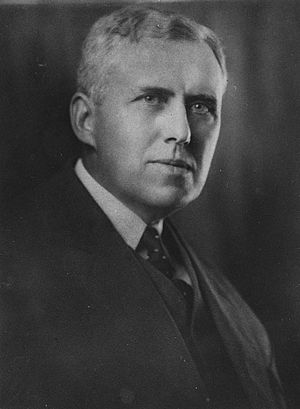Allyn Abbott Young facts for kids
Quick facts for kids
Allyn Abbott Young
|
|
|---|---|
 |
|
| Born | September 19, 1876 Kenton, Ohio, US
|
| Died | March 7, 1929 (aged 52) London, England
|
| Institution | London School of Economics |
| Alma mater | Hiram College University of Wisconsin |
| Doctoral advisor |
Walter F. Willcoxl Richard T. Ely |
| Doctoral students |
Frank Knight Edward Sagendorph Mason Edward Chamberlin Nicholas Kaldor |
Allyn Abbott Young (born September 19, 1876 – died March 7, 1929) was an important American economist. He was born into a middle-class family in Kenton, Ohio. Young sadly passed away at age 52 in London due to pneumonia during a flu outbreak. At the time, he was a leading thinker and the president of Section F of the British Association. What makes him special is that he had also been president of both the American Statistical Association (in 1917) and the American Economic Association (in 1925).
Contents
Life of Allyn Abbott Young
Early Life and Education
Allyn Young was a very bright student. He graduated from Hiram College in 1892 when he was only sixteen years old. This made him the youngest graduate ever from that college. After working in printing for a few years, he went to graduate school in 1898. He studied at the University of Wisconsin. There, he learned about economics, history, and statistics.
In 1900, he worked for a year at the United States Bureau of the Census in Washington, D.C.. Here, he made friends who would last his whole life. He returned to the University of Wisconsin in 1901. In 1902, he earned his doctoral degree. His main study was about how to understand age statistics.
Academic Career and Contributions
After finishing his studies, Young began teaching at many different universities. He taught at places like Western Reserve University, Dartmouth, and back at Wisconsin. From 1906 to 1910, he led the economics department at Stanford University. He also spent time teaching at Harvard University and Washington University in St. Louis.
In 1914, he became one of the first Fellows of the American Statistical Association. From 1913 to 1920, he was a professor at Cornell University. During World War I, he worked for the government in Washington D.C. He helped with statistics for the War Trade Board. He also worked in New York City to prepare for the Paris Peace Conference.
After the war, Young moved to Harvard in 1920. He taught there until 1927. Then, he accepted a special job at the London School of Economics (LSE). He stayed at the LSE for three years. Sadly, he passed away in London shortly after returning from a trip to the University of Chicago.
Young's Economic Ideas
Allyn Young was known for his deep understanding of economics. A colleague from the LSE, T. E. Gregory, said that Young was always looking for the full truth. He believed that economic ideas could come from many different ways of thinking. He wanted to understand all sides of a topic.
A famous economist, Bertil Ohlin, said that Young understood economics better than anyone he had ever met. Ohlin tested Young with a difficult question about capital. Young immediately gave a clear answer. This showed how much he knew about all parts of economic theory.
Young had many famous students who learned a lot from him. These included Frank H. Knight, Edward Chamberlin, and Nicholas Kaldor. He also advised Benjamin Strong, Jr., who was in charge of the Federal Reserve Bank of New York in the 1920s.
His most famous paper was called "Increasing returns and economic progress." He gave this speech in 1928. Some people, like Nicholas Kaldor, thought this paper was ahead of its time. Today, it is seen as an important early idea for modern "endogenous growth theory." This theory looks at how economic growth can come from within a country's own system.
Paul Samuelson, another famous economist, called Allyn Young one of the "American saints in economics." This shows how highly he was regarded by other experts in his field.
See also
 In Spanish: Allyn Abbott Young para niños
In Spanish: Allyn Abbott Young para niños

